What Can Beef Brisket Be Cut Into
Meat prices are rising, and rising fast. For some families that just means eating less expensive meat. For other families it can mean that they can't afford to buy enough protein for their families. If you've foregone meats because you chose to, that's one thing. But if, like us, you've cut back based solely on cost, I'm going to show you how you can put more meat in your freezer, for a lot less money.
What I'm going to suggest might sound counterintuitive, but bear with me. If you buy a large (and at first glance expensive) primal cut of meat and trim it down yourself, you'll save money. A lot of money.
We're going to show you how. Step-by-step.
This is the first in a series of posts designed to help you save a ton of cash on food, specifically meats, by buying primal cuts and portioning them out yourself. This may sound daunting at first, but it's really no more difficult or time-consuming than making potatoes from scratch once you get used to it.
This post will show you how to turn a $20.97 purchase into somewhere between $35 and $40 worth of prepackaged food. That's up to a 50% savings, depending on prices in your area. (This will vary. In some places the savings will be far more significant, slightly less in others.) And it all starts with a whole beef brisket.
If you're buying trimmed, ready to cook brisket in your local market, chances are you're paying upwards of $3.00 per pound. For the whole beef brisket we bought, the price came in at $1.90 per pound. This wasn't sale pricing. That's the everyday price at a national grocery chain. You already have a savings of about $1.00 per pound, and that's if you just whack that big boy down into a few smaller brisket segments.
What I'm going to show you goes farther. It's going to turn that primal brisket into 7 different pieces, including:
- 1 trimmed brisket
- 6 steaks
- 2 1-pound portions of stew meat
- 3 1-pound portions of stir fry or fajita meat.
All-in-all, the same meats bought at the same store would cost close to $40.00, so we got just about 50% off. This may differ for you, but it's still going to be significant.
What you'll start with is something that looks like this:

How to turn a whole beef brisket and save a ton of $$
It may seem hard at first, but really, turning this huge chunk of beef into smaller pieces isn't rocket science. It just takes a bit of planning and some time.
Preparation:
First; clean your counters well. Get rid of anything you don't need on your surface and scrub it well. I like to cover mine with freezer paper while working, just so I have less clean up at the end. As long as you've got a bleach cleaner to finish up the job with, the paper isn't necessary. You'll also need a plastic or teflon cutting board, so that you don't dull your knives or scratch your counters.
Next we need to consider knives.
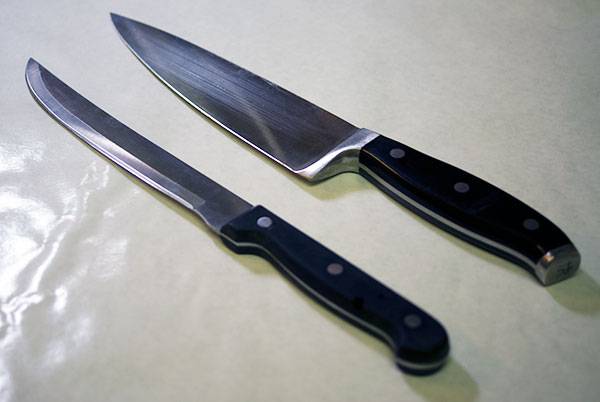
While I love my J.A. Henckels 8-Inch Chef's Knife (Pictured on right) and use it nearly every day, it's not really the right knife for this job. A far better choice is an inexpensive carving knife like the one pictured on the left. It has a much more flexible blade that is more forgiving for trimming meat and will make the final product much cleaner.
If you don't already have one of these, you can get it at most grocers, or through Amazon. in either case, you'll want a Traditional 8-Inch Slicing/Carver Knife. The shape and flexibility of this style knife will make your task easier.
Let's Get Butchering Your Whole Beef Brisket:
Now that you've assembled your tools, it's time to break that whole beef brisket out of the package.
First, wash your hands well. You can wear plastic or medical gloves if you want, but never start with unwashed hands. (Common sense, I know, but I have to mention it.)
Lay the brisket fat-side up on your counter and slowly and carefully start slicing away the fat cap. There's no need to be in a hurry here. You'll quickly find that there is a lot of fat on a brisket. Just trim down until you're shaving the last bits away from the body of the cut.
Here's a video that will walk you through trimming down your brisket.
(Note that instead of keeping the brisket as a whole piece, we've simply separated it at the cap end… Don't worry, you'll know where to cut.)
About half way through you'll notice that there is a vein of fat running through the middle of the brisket at the thickest end. Peel back the brisket and remove that, too. you'll end up with two large pieces of brisket and a mountain of fat that looks something like this:
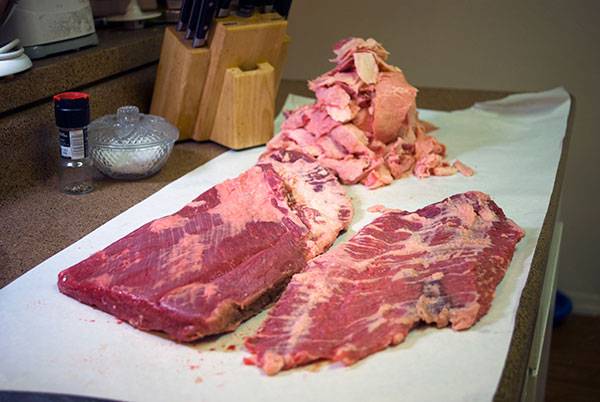
Now a lot more manageable than a whole beef brisket
Yep. That's a lot of fat. probably about 4 pounds worth. Don't throw that out! Pop it in a freezer bag and get it in the ice box pronto. We'll show you what to do with it in a later post.
Now that you've got your brisket broken down into its basic parts, it's time to consider what you want to do with it. This brisket got me two fair-sized chunks of pure beef.
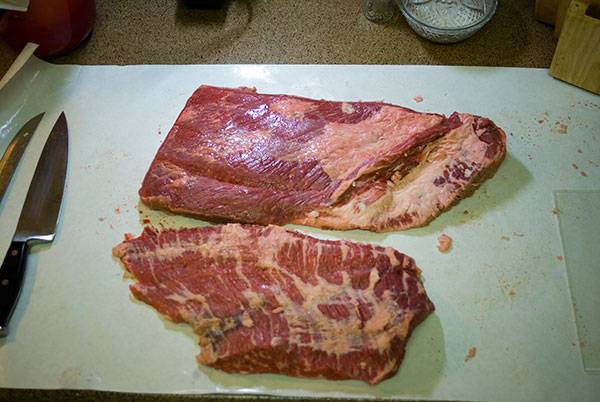
*Note that one end of the top piece is flat. That's because I've already cut off a 3 pound brisket from that end and have it resting in rub in the freezer for later in the month. Our diagrams will ignore that cut.
The left-hand side of the cut at the top is very lean, while it gets more marbled going to the right. The piece on the bottom is stringy and extremely well marbled. We have to take that into consideration when deciding what each piece would be good for in cooking. From my experience, this is how I portion these pieces out.
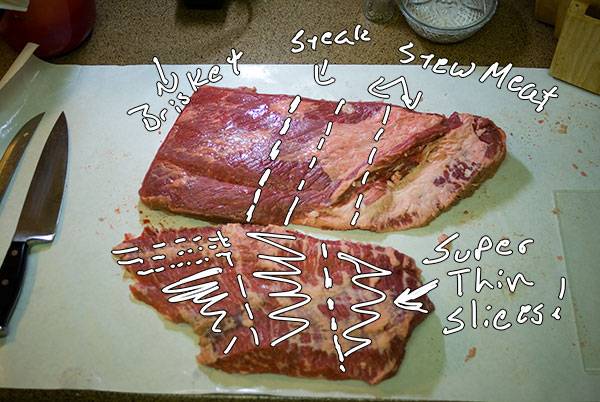
(Again, the diagram is skewed because I already trimmed the brisket piece. This is an approximation.)
On to the top piece. Cut the whole beef brisket off the end at the size you want it. (This is fast and loose, folks. If you don't want a whole brisket, cut more steaks, stew meat or kebab chunks, it's up to you. this post is a guide, not a definitive instruction manual.) Then part out the large cuts for steaks and stew meat. You'll end up with something like this:
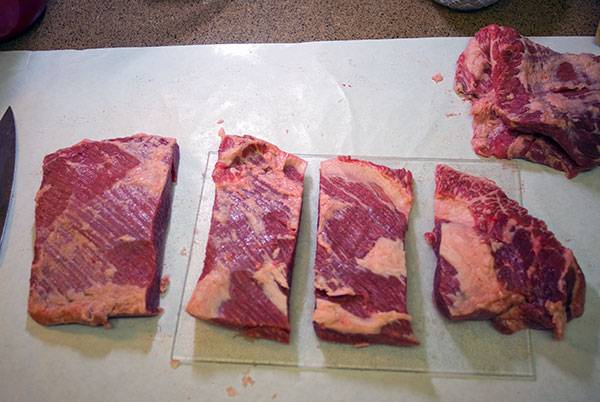
From left to right, I decided to cut these sections into 6 steaks, stir fry meat, and the last two as stew meat. I cut the entirety of the thinner piece of brisket into stir-fry meat.
After slicing it all up, we ended up with this:

What a whole beef brisket looks like when you've cut it down into 7 full meals
Not bad, eh?
Storage:
Now that you've got your whole beef brisket cut, you need to quickly store it away. Either use butcher paper or zip-top bags and get the meat to the refrigerator or freezer as quickly as possible. If you have plans for some of the meat on the same or the next day, the fridge is fine. Otherwise freeze it. The key is to get it chilled as fast as you can to avoid the meat coming to room temperature.
Clean Up:
This should go without saying, but the last thing you'll need to do is toss the butcher paper and spray your counters down with disinfectant spray, allowing the disinfectant to sit on the counter for at least three minutes before wiping it off. This avoids cross-contamination of foods later. It may seem fine to use just soap and water, but it really isn't. I strongly suggest a cleaner with bleach here, but you can use any disinfectant, just follow the directions carefully.
Now go enjoy some time with the family and bask in the glory of saving 50% on beef for the month. You deserve it.
If you try this, please let us know how you did! We'd love to hear if it went well or not, or what we can do to make these tutorials better or help you save money on your bills.
delanceytence1988.blogspot.com
Source: https://www.unclejerryskitchen.com/diy/how-to-turn-a-whole-beef-brisket-into-7-full-meals-and-save-a-ton-of-money/
0 Response to "What Can Beef Brisket Be Cut Into"
Post a Comment